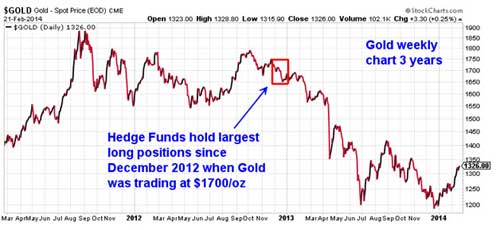 |
When gold prices fell to around $1,200 an ounce late last year, a lot of investors complained that the market was being manipulated. But I argued then that the real reason for gold’s decline was more mundane than a conspiracy. It was simply the result of disinterest among speculators.
Long positions among hedge funds reached a peak in October 2012, corresponding with a price of about $1,700 an ounce. For the next 14 months, hedge funds shifted en masse into short positions, causing the bear market that hit its nadir in December.
But since then, speculators have changed course again. And as you might expect, the shift among hedge funds from short to long positions has resulted in a rebound in the gold market.
This should be all the evidence you need that speculators drive our modern markets. When hedge funds are buying, prices rise. When they are selling, prices fall. Sometimes, it really is as simple as that.
I don’t pretend to understand the motivations of speculators. Their actions are rarely guided by fundamentals, or even technical analysis, and those actions are impossible to predict with any accuracy. So instead, individual investors must simply try to keep up with them, and react to the trend changes they cause.
On that front, it has become clear to me that the trend has changed — not just in gold but across the commodity sector. You name it — coffee, sugar, hogs, soybeans, wheat, corn, silver and, of course, gold. Shorts are getting obliterated on all fronts, and prices are surging.
There is a fundamental element to this trend shift. Equities have been overvalued, and commodities undervalued. But it seems to me that the turnaround has more to do with weakness in the U.S. dollar, caused by recent disappointing economic data.
So how long will this new trend last, and how far will it go? Frankly, I have no idea, and neither does anyone outside of the world’s largest hedge funds. I do have my doubts that this newfound strength in commodities is sustainable. Whenever shorts are taken out in such huge numbers, across so many markets all at once, it indicates an indiscriminate macro trade. That kind of buying rarely lasts.
But for now, it would be foolish to argue with the charts. As investors, we must respect the technicals, which have turned decidedly bullish. At the same time, we must remain vigilant for signs that this mad buying binge is fizzling out.
Best wishes,
Douglas


{ 1 comment }
You could be correct.Maybe,after 100 years of successfully devaluing the currency,even faster since the Dollar went totally fiat,in 1971,the trend is over.Good luck with that.